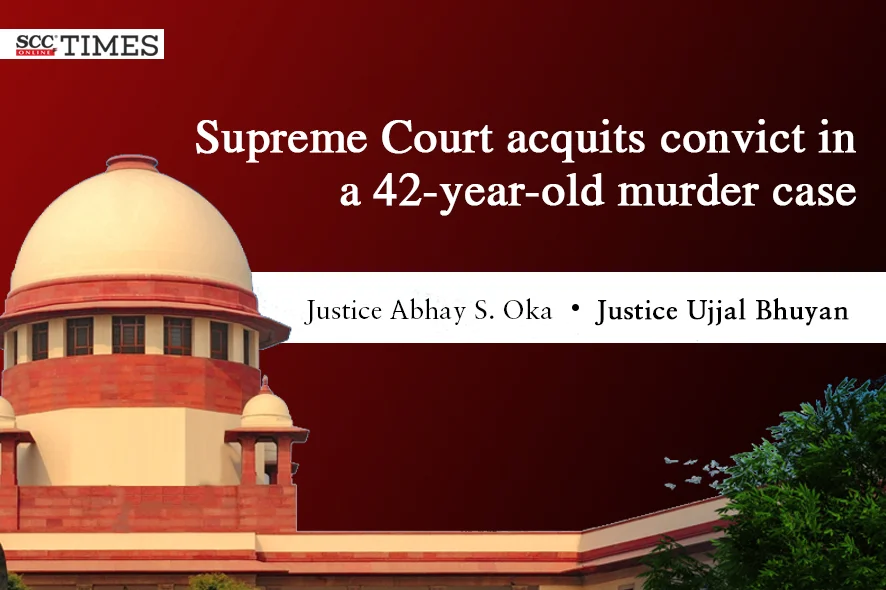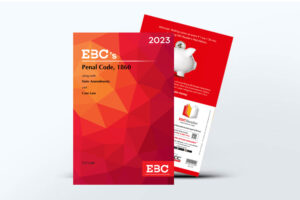Supreme Court: In a criminal appeal directed against the judgment and order passed by the Allahabad High Court confirming the conviction and sentence imposed on the convict for the offence under Section 301 read with Section 302 of the Penal Code, 1860 (‘IPC’) by the Additional Sessions Judge, the division bench of Abhay S. Oka and Ujjal Bhuyan*, JJ. while setting aside the conviction and sentence of the convict, said that the convict should be given the benefit of doubt as the prosecution could not prove his guilt beyond all reasonable doubt as the evidence tendered by the eyewitnesses suffer from serious lacunae. Thus, their evidence cannot be said to be credible.
Background:
The informant lodged a first information report at midnight stating that he and his brother were sitting in the open space in front of the entrance door of his house during the evening hours. His mother was sitting close by on a cot. On another cot, neighbours were sitting. Thereafter, the convict holding a country made pistol along with the co-accused came to his residence. As per version in the first information, the co-accused had instigated the convict by loudly saying that these people were creating disturbances; so, kill them. The convict fired at the informant, but he slipped below the cot. The bullet hit the left breast of his mother who died immediately due to the gunshot wound.
The Police investigated the crime and on completion of the investigation submitted a charge sheet charging the convict of having committed the offence under Sections 301 and 302 of the IPC. On the other hand, the co-accused was charged of having committed an offence under Section 307 read with 34 IPC. For offence under Section 301 read with Section 302 IPC, the convict was sentenced to undergo imprisonment for life and for the offence under Section 307 IPC, the convict was sentenced to undergo rigorous imprisonment for five years, both the sentences to run concurrently. However, the co-accused was given the benefit of doubt and accordingly was acquitted.
Analysis:
The Court noted that the prosecution has not examined the material witnesses. Further, the weapon of the offence i.e. the country made pistol used by the convict, could not be recovered by the police and therefore not exhibited. Thus, the main material evidence, i.e., the weapon of offence was not exhibited. From the seizure memo, it noted that a 12-bore cartridge was lying on the cot and along with the tikli of the cartridge, which was stuck on the wound of the deceased, were seized by the police. Further, in the evidence of the doctor and the post-mortem report, it noted that 55 small pellets were taken out from the deceased’s body during post-mortem.
The Court said that as the bullet wound was bone-deep, this reveals that the deceased was shot at from close range.
The Court further said that the pellets as well as the tikli of the cartridge were not sent to any ballistic expert, as a result of which there is no ballistic report on the basis of which it could be said for sure that the pellets found outside the body and from within the body could be traceable to the tikli of the 12 bore cartridge which in turn could be traced to the country made pistol from which the shot was allegedly fired by the convict. There is no explanation of the prosecution regarding the 55 pellets retrieved from the body of the deceased during post-mortem. Further, the blood-stained clothes of the seized deceased were sent to the chemical examiner, but the report from the chemical examiner was not received till the date and time of his deposition.
Thus, the Court said that there are glaring inconsistencies in the prosecution version which have been magnified by the absence of the testimony of the material witnesses and the ballistic report coupled with the non-recovery of the weapon of crime.
After taking note of Sukhwant Singh v. State of Punjab, (1995) 3 SCC 367 the Court concluded that in cases where injuries are caused by firearms, the opinion of the ballistic expert becomes very important to connect the crime cartridge recovered during the investigation to the firearm used by the accused with the crime. Failure to produce expert opinion in such cases greatly affects the prosecution case’s creditworthiness. However, as per State of Punjab v. Jugraj Singh, (2002) 3 SCC 234, when there is convincing evidence of eyewitnesses, non-examination of the expert would not affect the creditworthiness of the version put forth by the eyewitnesses.
The Court said that non-recovery of the weapon of crime would not be fatal to the prosecution case. When there is such non-recovery, there would be no question of linking the empty cartridges and pellets seized during investigation with the weapon allegedly used in the crime.
Further, it said that obtaining ballistic reports and examination of the ballistic expert is not an inflexible rule. It is not that in each and every case where the death of the victim is due to gunshot injury that opinion of the ballistic expert should be obtained, and the expert be examined. When there is direct eye witness account which is found to be credible, omission to obtain ballistic report and non-examination of ballistic expert may not be fatal to the prosecution case, but if the evidence tendered including that of eyewitnesses do not inspire confidence or suffer from glaring inconsistencies coupled with omission to examine material witnesses, the omission to seek ballistic opinion and examination of the ballistic expert may be fatal to the prosecution case.
The Court said that in the present case, the evidence tendered by the eyewitnesses suffer from serious lacunae. Thus, their evidence cannot be said to be credible. Further, the material witnesses have not been examined. Thus, the evidence tendered by the prosecution cannot be full proof so much that non-recovery of the weapon of offence, non-obtaining of ballistic opinion and non-examination of ballistic expert would be immaterial. Therefore, the Court held that the prosecution could not prove the accusation against the convict beyond all reasonable doubt.
The Court also said that on the same set of evidence, the Trial Court gave the benefit of doubt to the co-accused, primarily on the ground that there was a grudge between the convict and witness.
Thus, the Court viewed that the convict should be given the benefit of doubt as the prosecution could not prove his guilt beyond all reasonable doubt. It further remarked that any lingering doubt about the involvement of an accused in the crime he is accused of committing, must weigh on the mind of the court and in such a situation, the benefit of doubt must be given to the accused This is more so when the co-accused is acquitted by the trial court on the same set of evidence.
Thus, the Court set aside the conviction and sentence of the convict. Further, it quashed the judgment and order of the Additional Sessions Court and the High Court.
[Ram Singh v. State of U.P, 2024 SCC OnLine SC 170, decided on 21-02-2024]
*Judgment Authored by: Justice Ujjal Bhuyan
Know Thy Newly Appointed Supreme Court Judge: Justice Ujjal Bhuyan








